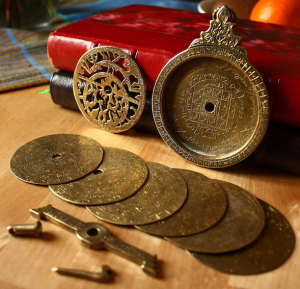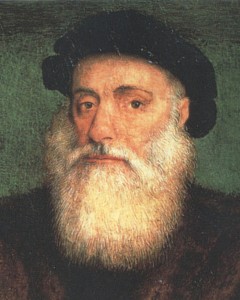A rare bronze astrolabe navigational instrument belonging to a shipreck from Vasco da Gama’s 1502-1503 voyage of exploration to India has been identified by scientists from the University of Warwick.
Astrolabes, the bronze graded discs used by renaissance mariners to determine their latitude, are extremely rare… until recently only 107 had been found in the world. But this one, found by underwater archaeologist and shipwreck hunter David Mearns, of West Sussex, diving on a ship that sunk in the Indian Ocean in 1503 has been confirmed as the 108th.
The astrolabe was discovered by the Mearns himself diving in 2014, but it has not been fully identified until recently, when a team from the University of Warwick using laser scanning technology were able to discern five degree markings on its rim. The bronze relic is 17.5cm in diameter and a mere 2mm thick, one of the thinnest to have survived. It carries the emblem of Dom Manuel the 1st, who became king of Portugal in 1495. This neatly dates the artefact to between 1495 and 1502 when the ships left Lisbon.
Astrolabes were circular, typically with a mother disc holding one of several secondary discs that pertained to a specific latitude. Over these a rete – or lattice frame with pointers denoting the positions of the brightest stars and sun, is free to rotate as a star chart – one rotation marking a day. Some astrolabes also had a rule with a scale of declinations.

disassembled Astrolabe showing the mother disc, local latitude discs, rete frame and rule: Evan Bench, Paris
Mearns’ Bluewater Recoveries team, together with Oman’s Ministry of Heritage & Culture (MHC), have been recovering 2,800 artefacts from the shipwreck of the Esmeralda, an East Indiaman, or nau, one of the 20-ship fleet of Portugal’s fourth voyage of discovery to India in 1502–1503. The ship sank in a storm on rocks after it was driven off its anchorage at Al Hallaniyah Island and was discovered by Mearns in 1998 – the 500th anniversary of da Gama’s epic discovery of the sea route to India from Portugal.
The Esmeralda was one of five ships commanded by Vicente Sodré, Vasco’s uncle and the fleet’s second in command. With three naus and two caravels Vicente had been ordered to patrol and guard the waters off Cochin and Cannanore on the South West Coast of India, where the Portuguese had set up factories while Vasco returned to Lisbon with the rest of the fleet. But instead, in April 1503, Vicente with his brother Bras in command of the nau São Pedro and the three other ships, went north to the Gulf of Aden, where they conducted a piratical cruise, capturing, looting and burning arab dhows, before stopping to rest from the southwest monsoon and careen at Hallaniyah Island in Oman. There local fishermen warned the Portuguese captains of a coming northerly storm but they trusted their anchors to hold their larger naus – while the two smaller caravels made for a safer anchorage.
In the ensuing storm, both Sodré brothers’ naus, São Pedro and Esmeralda were lost. Many of the São Pedro’s crew and her captain Bras survived by scrambling over the rocks, but the Esmeralda, her crew and Vicente all perished in the deeper waters of the anchorage. Bras died soon afterwards of unknown causes.
The whole story was chronicled by the third captain Pêro de Ataíde who wrote an account of the ill-fated cruise for Dom Manuel I, before he died in a shipwreck on Mozambique – on his way home in 1504. The story was chronicled in the pictorial Livro das Armadas – of Portugal’s various voyages of discovery to India between 1497 and 1566.
You can see the moment the divers found the astrolabe disc: HERE
Main photo: BBC





